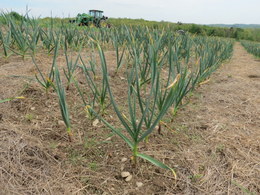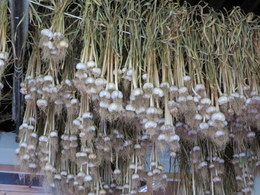Garlic Growing Guide
Garlic (Allium spp.) is one of the herbs that is easy to grow and has few pest problems. It is grown around the world and is used in cooking and for medicinal purposes in many cultures. There are more than 300-varieties. It has a characteristic pungent flavor and is related to onion, shallot, chive and leek.
Softneck and hardneck are the 2-major types of garlic.
Softneck garlic (Allium sativum subsp. Sativum) is generally grown in the warmer southern states with California being the largest producer and is very likely what you will find in the supermarket. This variety does not have the flowering scape, but may have 8 to 20 small cloves.
Hardneck garlic (Allium sativum subsp. Ophioscorodon) is the type that grows best in the cooler climates and is the most popular type grown by the home gardener. This variety may have 4 to 6 large cloves and has a central flowering stalk or scape.
Elephant Garlic (Allium ampeloprasum) is popular for its very large bulbs, which more often than not are roasted. It has a sweeter and milder flavor and is more closely related to the leek family.
Seed garlic is not usually found in your local garden center, but is available at many online sources. Another option is to go to your farmer’s market in the late summer and buy a bulb. Ask if it was grown locally and if so, you can be assured that it will be suitable to grow in your garden.
The farmer may also be willing to tell you the variety it is. Each clove you plant will grow into a bulb with many cloves just like the one you planted. Ask them if they are organically grown. Many farmers follow good organic gardening practices, but do not go through the expensive certification process.
Do not buy a garlic bulb from a grocery store and expect good results. It most likely was grown in California and is a softneck variety that is not suitable for your climate, and was grown for its shipping qualities not flavor. The bulb may also have been treated with a chemical that will retard sprouting just as potatoes are treated.
Soil Preparation
The cloves should be planted in full sun in soil that has enough organic matter and drains well. Wet soil will cause the cloves to rot. The cloves can be planted in rows or in a container. Till or dig the soil 6 to 12 inches to loosen the soil to allow the roots to fully develop. Soil pH should be 6.2 to 6.8.
When to Plant
The best time to plant the cloves is in the fall about six-weeks before the ground freezes. The cloves need some time to start forming roots before the ground freezes in the same way that tulips and daffodils do.
Do not plant too early. Ideally the soil temperature should be under 50°F. If it is planted too early and the soil temperature is too warm the leaves will start growing, which will die off during the cold winter months. This should not kill off the cloves, but will take away the energy stored in the clove that has to be used in the warmer spring weather.
How to Plant
A bulb will have many individual cloves. Separate the cloves a few days before planting leaving the papery skin on the cloves. The cloves should be planted in the same direction as they were on the bulb, that is, with the pointed end up and the flat root end down.
In general plant the cloves 6 to 8 to inches apart in all directions and 2 inches deep. Cover with soil and pat lightly down.
Elephant garlic cloves need more room to grow and can be planted in rows 6 to 8 inches apart and 3 to 4 inches deep.
If planting in rows do not make the rows too wide. Weeds need to be removed so that they do not take over. A planting bed width of 3 to 4-feet will allow weeding from the aisles.
If planting in a container you have many options to choose from. A half of a wine barrel can be used as well as a barrel with the ends removed. Another way is using a garlic grow bag such as one from Gardener’s Supply Company. In it you can plant 18 to 20 cloves. This will give you good results if all you have is a small space on a patio or a deck.
Watering and Care
When the plants are a few inches tall add a nice loose mulch of shredded leaves or pine straw to shade the plant roots. This will keep the weeds out, the soil cooler and help retain moisture. Keep the mulch a couple of inches away from the stem. During dry spells give some water each week. If planted in a container they will need to be watered more often to insure that they do not dry out.
Harvesting Garlic
The time to harvest the garlic bulb is when the foliage starts to turn yellow and die back. If you harvest too soon the bulb will be under developed and if you wait too long the wet soil will cause the thin paper covering to come off letting the cloves separate. In most places this will happen in July. You can carefully probe alongside the bulbs to see how large they are.
When the bulbs are ready, use a garden fork to carefully loosen and lift the garlic out of the ground. Lightly brush off any loose soil and set aside to dry in a dark location. This will allow the foliage to dry out. Old window screens raised up off of the floor are an excellent way to spread out the garlic for drying.
A popular way after drying is to braid the dried foliage. Start out with 3 bulbs and start braiding, adding another bulb after a few inches and then continue adding another every few inches. After you have a string of bulbs braided, tie string to the braid. This will give you a handy way to hang the garlic bulbs in a cool dry place. You also can simply tie the dried garlic foliage of a group of garlic bulbs together and hang them up to dry.
Popular Garlic Varieties
Hardneck:
Ajo Rojo, Chesnok Red, Elephant, Georgia Crystal, German Red, Montana Giant, Music, Purple Glazer, Russian Red, Siberian, Sonoran, Spanish Roja.
Softneck:
California Early, Chinese Purple, Early Italian, Inchelium Red, Italian Late, Italian Loiacono, Lorz Italian, Nootka Rose, Polish Softneck, Red Janice, Red Toch, Shilla, Silver Rose, Silver White, Simonetti, Transylvania, Walla Walla.
Some hardneck varieties prefer the cooler northern climate conditions. Many hardneck varieties and softneck varieties will do well in all types of climates.
Sources: Seeds Now, Burpee, Harris Seeds
Diseases and Pests
Fungal diseases such as powdery mildew, downy mildew, fusarium, botrytis, and white rot are the most common.
Prevention is the best way to control any problems by removing any infected bulbs and plant leaves and toss them into the garbage, not the compost pile.
Garden Spikes newsletters give you timely information once or twice a month. Subscribe Free to the Garden Times newsletter below.
Your email address will only be used to send you a newsletter and will never be sold. You can unsubscribe at any time.


